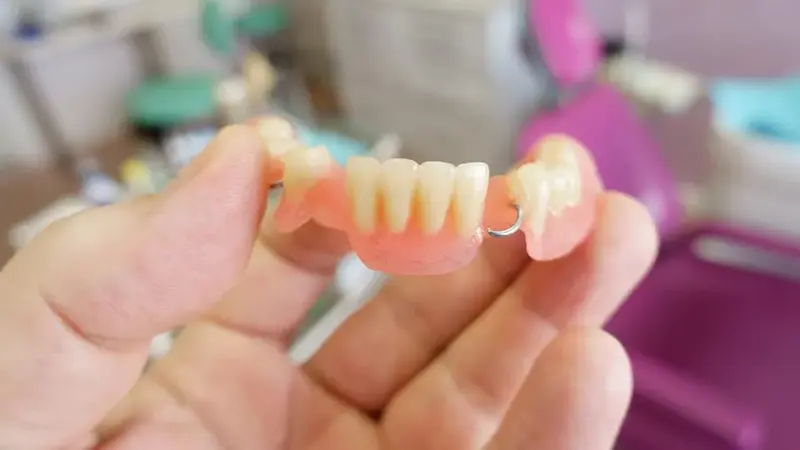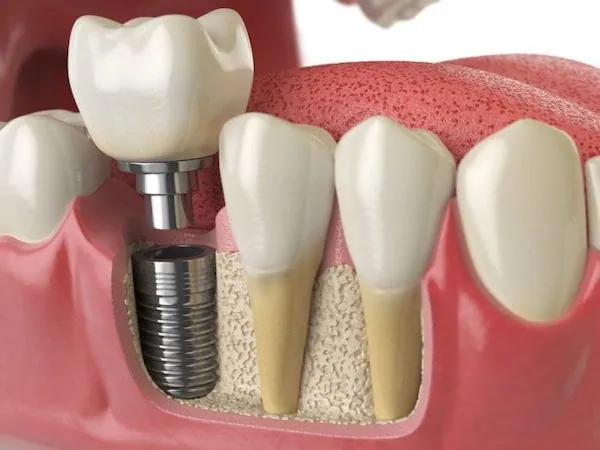Restoring missing teeth is crucial for maintaining dental health and self-assurance. Missing teeth not only affect your smile’s aesthetics but can also give rise to other dental problems like an imbalanced bite, eventually leading to tooth decay.
An effective remedy for missing teeth is the use of partial dentures. These dentures operate much like regular or full dentures, with the key distinction being their ability to attach to the remaining natural teeth along the upper or lower gum line.
Continue reading to discover essential information about partial dentures and determine if they are a suitable option for you.
What are partial dentures?
Partial dentures are a dental solution used to replace one or more missing teeth, addressing both functional (chewing and biting) and aesthetic concerns. These dental appliances consist of artificial teeth attached to a base made of plastic or metal, colored pink to blend with the roof of your mouth.
Partial dentures are removable and require regular cleaning, as they are not intended to be a permanent fixture like dental implants.
In situations where multiple teeth are missing, partial dentures can be especially beneficial because they can be custom-designed to attach to neighboring teeth, effectively filling in all the areas where teeth are missing.
Partial dentures vs. Dental Implants
Partial dentures and dental implants have several notable distinctions, with the most significant difference being their removability. Dental implants are considered the superior option for tooth replacement as they closely resemble natural teeth in both function and sensation and are permanently fixed in the mouth.
However, there are circumstances where individuals may not be ideal candidates for implants and may choose dentures instead:
- Presence of other health issues.
- Insufficient bone structure beneath the gumline.
- Incompatibility with medications an individual is taking.
- Financial considerations, as implants can be expensive.
In such cases, partial dentures offer a viable alternative for replacing missing teeth.
Types of partial dentures
There are two main types of partial dentures that individuals can choose from:
- Clasp denture: This type of partial denture remains in place by clasping onto adjacent teeth using thin and inconspicuous metal clasps.
- Overdenture or implant-retained denture: If a person has sufficient bone structure to support implants, this type of denture can be attached to inserted implants, providing a more secure and comfortable fit.
Your dentist will guide you in selecting the most suitable type of partial denture for your needs. Before determining the appropriate treatment, your dentist will conduct a thorough examination of your mouth, considering the condition of your existing bone structure.
Who are partial dentures for?
Partial dentures are particularly beneficial for individuals who have a few missing teeth or those with mostly healthy natural teeth. It is important to preserve natural teeth whenever possible, and partial dentures offer good retention by utilizing the natural teeth as anchors, minimizing movement during chewing.
The process of getting partial dentures
The process of getting partial dentures typically involves multiple appointments with your dentist. Here is a breakdown of the steps involved:
Step 1: Comprehensive exam
A comprehensive examination is conducted to assess the condition of your mouth. It is important to address any active dental issues before fabricating the partial dentures. The dentist will carefully evaluate your edentulous ridge, the area where the partial denture will replace the missing teeth, ensuring there are no sharp bony protrusions or root tips that could cause discomfort.
Step 2: Surgery to remove tooth fragments
If necessary, a minor surgical procedure may be scheduled to remove any remaining tooth remnants, such as root tips or bony areas. This procedure requires local anesthesia, and proper planning for transportation to and from the dental office is advised.
Step 3: Fabrication of partial dentures
Once the mouth has healed from the surgical procedure, the denture appliance is made. This process involves custom impressions and a wax rim try-in to establish the correct bite, ensuring a proper fit and comfortable feel of the partial dentures.
Step 4: Fitting and adjustments
Patients will have a try-on appointment to verify the size, shape, and color of the teeth for the partial dentures. Following this, the final delivery of the dentures takes place. In the subsequent weeks, there may be a few adjustment appointments to address any sore spots that may occur initially.
By following these steps, individuals can expect to receive well-fitting and comfortable partial dentures. Regular follow-up visits with the dentist are crucial to ensure proper maintenance and adjustments, if needed.
How much do partial dentures cost?
The cost of partial dentures can vary significantly, but it is generally more affordable compared to dental implants. The cost depends on factors such as the provider’s experience, the quality of the laboratory, and the location. On average, the price range for a set of partial dentures is typically between $1,000 and $4,000.
Does insurance cover partial dentures?
Insurance coverage for partial dentures varies among plans. Many dental insurance plans offer coverage for restorative care, with coverage typically around 50% of the cost. However, it’s important to review your individual plan to understand the specific coverage, including co-pays, deductibles, and yearly limits.
Some insurance plans may have limitations on the coverage amount, which could affect the coverage for partial dentures, especially if you have already received extensive dental work within the same calendar year. It is recommended to contact your dental insurance plan to clarify the costs and coverage before proceeding with the procedure.
Does Medicaid cover partial dentures?
Medicaid coverage for partial dentures depends on the state you reside in. Some states provide dental benefits under Medicaid that include provisions for dentures, while others may not offer dental benefits for adults on Medicaid.
The Center for Health Care Strategies offers a state-by-state guide to dental benefits provided by Medicaid, which can provide more specific information.
Proper care of removable partial dentures
To care for removable partial dentures, it is necessary to remove them every evening for cleaning, as per Dr. Asaro’s advice. Proper home care involves using a soft- to medium-bristled toothbrush to clean the dentures thoroughly. Over-the-counter denture cleaning tablets can also be beneficial for maintenance.





